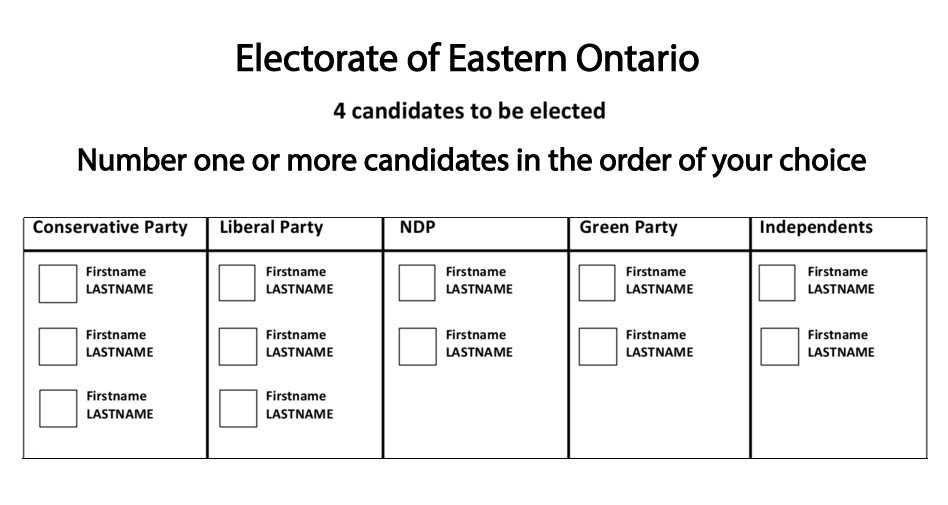Is STV "too complicated"?
- Anita Nickerson
- Apr 2, 2016
- 5 min read
A reaction I hear a lot when I mention STV is that it's "too complicated."
Although I find this frustrating, I understand. I used to believe that, too.
My Personal Experience
When I discovered the concept of proportional representation - that 30% of the vote should earn a party about 30% of the seats and my vote should count - I was initially in touch with PR supporters who mainly advocated for Mixed Member Proportional (a system I would also still support).
When you're standing at a table trying to collect signatures, the truth is, no matter how strongly you believe that any decent proportional system will fix the worst deficiencies of first-past-the-post, after a while you have to be able to explain something concrete when a guest asks,
"Yes, I get that, but HOW does it work?"
MMP was the first thing I learned how to explain.
I learned how to draw a quick MMP ballot on a napkin. Then I made a pamphlet for our local group, "PR Made Easy", about how MMP works, according to description in the Law Commission report (at that time I had no idea all the different varieties of it).
I knew STV existed but sometimes I got the impression from other PR supporters that it wasn't really something we talked about because I was told it was "unsuitable" for Canada at the federal level" or "only suitable for a board election."
MMP was so much like our current system I imagined it would be easier to get people on board (despite that STV got 58% in the BC referendum and MMP failed two provincial referendums, the logic still made sense to me).
"Too complicated to explain to voters" was something else I heard about STV a lot.
Being someone who is easily intimidated (for good reason in my case) by anything to do with math, and trusting the opinions of those fighting for PR longer than I, just assumed they must be right.
A quick glance at STV - seeing words like "quotas" and "surplus transfers" - and imagining myself trying to explain such things to anyone - just reaffirmed my pre-existing belief. I was stuck in my comfort zone.
For many years I was just too intellectually lazy - and extremely busy campaigning for PR - to investigate further.
I won't go into detail about the process that led me to take a second look at STV, but I can tell you this. Once I finally did, I discovered one thing:
STV is not Complicated, and It Has a Lot Going for It, Too
With STV, voters rank candidates in a multi-member local district.
So, for example (the number of MPs elected per district can vary), 5 single member ridings now would be combined into one local district electing a team of 5 MPs.
You will have an MP whose office is just as close by as now, and an MP you helped elect who represents your values.
In my area, I'd probably have one MP of the party of my first choice and at least two others I liked pretty well. I could talk to any of them.
Instead of one party sweeping every seat in an area, each district would elect a diversity of local MPs which reflect how people voted.
But how hard is the ballot compared to other PR systems?
One thing you might not realize is that 100 years ago, when people said "proportional
representation", they meant STV. MMP had not been invented. When MacKenzie King's Liberals ran on implementing proportional representation in 1921, they meant STV.
Take a look at two ballots below right now - click on each to enlarge. These are fairly realistic simulations of what voters would use in a riding in Eastern Ontario with MMP and STV. (MMP ballot: credit to Fair Vote Canada).
On the left is an STV ballot. Here's what you do: Just rank as many candidates as you want. Only like the Liberals and don't care who the candidates are? Just put 1, 2 and 3 by the Liberal names.
Maybe you like one of the Green candidates best, but also like one of the candidates from another party, and hey, that Independent isn't bad. 1, 2, 3... across party lines. You can mark as few or as many as you feel like.
As you can see, it's not that scary. Many people imagine an STV ballot as a long list with 100 names.
In reality we only have a few major parties in Canada, the natural threshold with any Canadian proportional system means we won't see any explosion of new parties, and with STV, parties usually only run as many candidates as they figure they have a good chance to elect.
As a voter, here are two things you won't need to worry about with either MMP or STV:
1) Using the formula to calculate who gets how many regional seats with MMP
2) Using the formula to calculate who gets the 4 local seats with STV
In either case, you'll just see that the results were proportional.
If you want to understand how the votes are counted:
The simplest way to count ballots with STV - no quota, no surplus transfers.
To try this at home, you could print off a bunch of blank ballots, rank them all differently (pretending to be different voters), and do this at your kitchen table in five minutes.
Or just imagine doing it :).
Sort the ballots by first preference (all the voters who chose Bob first go in the Bob pile, those who chose Sarah first go in the Sarah pile).
You'll have a pile of votes for each candidate who ran.
Then just keep eliminating the candidate with the smallest pile of votes and transferring the ballots of people who voted for that person to their second choices.
After a short time you'll have as many candidates left as you have seats - those are your winners.
This simple method gives the same results as the method with the extra steps described in the videos below 97% of the time.
The method with two extra steps
To see the method with two extra steps, I'd suggest you watch the 3 short videos on the video page of this site, and read the description underneath them. If you don't want to click, here are the two Animal Kingdom videos right here:
Lots of places use STV for elections for more than one position, including Fair Vote Canada.
STV - with the two extra steps of setting a quota to be elected and transferring surplus votes, which is not hard, either - is used in Ireland and even a potato farmer with a grade eight education can use the ballot and understand how it works.
Scotland switched to STV for its local elections and nobody's complaining it's too complicated. The government in Ireland produces a really cool animation of how the votes were transferred in each local district if you want to know not just who won the local seats, but exactly how the ballots were transferred. Go here and click play! If 80+ countries around the world, including most of the OECD, use forms of PR and their voters can understand it, so can we. Some scratch-and-win tickets are more complicated.
Just using it once is the best practice.
After the Election, All Voters will Observe:
1) Which MPs they helped elect
2) Which MPs will represent them in their local district
3) That the overall results, both in their district and nationally, are proportional to how people voted
Other Benefits of STV for Voters
A lot of the other benefits of STV are covered in STV Values.
These include:
1) making almost every vote count
2) proportional results
3) diversity of candidates elected
4) a team of local representatives, and
5) more cooperative politics.
Most of these benefits above apply to other PR systems, too. Many people also believe STV does the best job of loosening the iron grip of parties just a bit, by giving voters maximum choice between candidates. It also gives popular independents a realistic shot. To quote the BC Citizens' Assembly, "STV puts voters in the drivers seat."













Comments